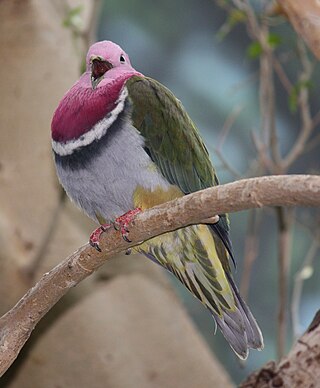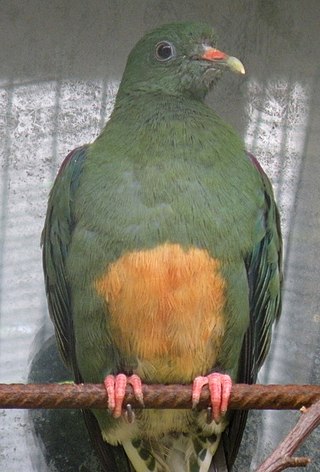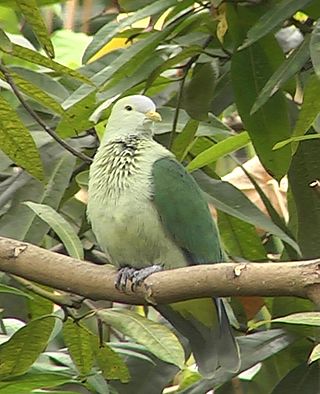
The superb fruit dove, also known as the purple-crowned fruit dove, is a medium-sized, colourful fruit-dove in the family Columbidae.

The pink-headed fruit dove also known as pink-necked fruit dove or Temminck's fruit pigeon, is a small colourful dove.

The wompoo fruit dove, also known as wompoo pigeon, is one of the larger fruit doves native to New Guinea and eastern Australia.

The black-chinned fruit dove, also known as the black-throated fruit dove or Leclancher's dove, is a medium-sized bird of the family Columbidae. The male is a colorful bird with a green belly and wings, a brown tail, a whitish grey head and neck with a purple base, red iris and a small black patch under its yellow bill. The female has a green head, neck and breast.

The beautiful fruit dove, also known as the rose-fronted pigeon or crimson-capped fruit dove, is a small, approximately 19 cm long, mainly green fruit dove. It has a red crown, whitish throat, a greenish-yellow bill and purplish-red feet. It has a blue-grey breast and yellowish orange belly, with a reddish purple patch in between. Both sexes are similar.

Wallace's fruit dove is a species of bird in the pigeon family Columbidae. The name commemorates the British naturalist Alfred Russel Wallace. It is a rather large, long-tailed fruit dove with a length of 24–28 cm (9.4–11.0 in) and has been described as "one of the most beautiful" fruit doves. The forehead and crown are dull crimson, the lower face and throat are white, and the rest of the head, breast, neck, and upper back are pale bluish-grey. The wings and lower back are green and the belly is orange, separated from the chest by a white band. Both sexes look similar, but females have less extensive red on the head and a greenish tinge to their grey parts.

The rose-crowned fruit dove, also known as pink-capped fruit dove or Swainson's fruit dove, is a medium-sized, up to 22 cm long, green fruit dove with a grey head and breast, an orange belly, whitish throat, yellow-orange iris, and greyish green bill and feet. It has a pinkish-red crown with yellow border. The Indonesian subspecies, P. r. xanthogaster, has a whitish crown and paler grey head and breast. Both sexes are similar. The young has a green-colored crown and plumage.

The orange-bellied fruit dove is a small pigeon with mainly green plumage, distinguished by a large orange patch on the lower breast and belly, a small lilac shoulder patch, pale yellow undertail coverts, and a grey terminal band on the tail.

The white-bellied imperial pigeon is a species of bird in the pigeon family Columbidae. First described by the French ornithologist Charles Lucien Bonaparte in 1854, it is endemic to Indonesia, where it is found on Sulawesi, Buton, Taliabu, Togian, and Peleng. It inhabits primary forest, dense secondary forest, and isolated areas of hill forest. A large pigeon with a long tail, it measures 42.5–51.5 cm (16.7–20.3 in) long and weighs 510 g (18 oz) on average. Males are mainly green, with pale-grey heads and bellies, chestnut vents, and a pale grey tail band, along with a red orbital ring. Females are nearly identical, but have darker grey areas in their plumage.

The Negros fruit dove is a species of bird in the pigeon and dove family, Columbidae. It is endemic to the island of Negros in the Philippines. This fruit dove is known from a single female specimen collected from the slopes of Mount Kanlaon in the northern part of the island. While it was found at a high elevation, it is suspected that the species originally lived in the lowland dipterocarp forests and was driven to higher elevations by habitat destruction. While some have suggested that the specimen is either a runt or a hybrid instead of a valid species, this is not widely accepted. The female Negros fruit dove was a small fruit dove with vivid dark green plumage and an ashy-grey forehead. It had a distinctive ring of bare yellow skin around its eye, and yellow fringes to some of its feathers gave it the appearance of having a yellow wingbar when perched. The throat was white, while the undertail and vent were yellow.

The scarlet-breasted fruit dove is a species of bird in the family Columbidae. It is endemic to Indonesia, where it occurs in the northern Moluccas. Its natural habitat is subtropical or tropical moist lowland forests. It is rated as a species of least concern on the International Union for Conservation of Nature Red List of Endangered Species. In 1863 Hermann Schlegel named the new species for one of his collectors, Heinrich Agathon Bernstein.

The Makatea fruit dove is a species of bird in the family Columbidae. It is endemic to French Polynesia island of Makatea in the Tuamotu Archipelago. Its natural habitat is subtropical or tropical moist lowland forests and is also present near villages. This bird is approximately 20 cm tall and has plumage of mostly green feathers with a dark purple crown and forehead, pale greenish-grey throat and chest, cloven lower chest feathers producing rows of shadows that appear as streaks, yellow underparts, tinged orange anteriorly. The bird's wing feathers are edged yellow. While it continues to be threatened by habitat loss, a decrease in mining since the mid 1960s has helped re-vegetation and appears to have stabilized population numbers.

The white-headed fruit dove is a species of bird in the pigeon family Columbidae. It was described by the English ornithologist John Gould in 1856, and the specific name eugeniae honours the French empress Eugénie de Montijo. Adults of the species have white heads, a purplish-red breast patch, a grey shoulder patch, olive-green upperparts, greenish underparts with a blue tinge, and a yellowish vent. Juveniles have green heads with the white restricted to the forehead and upper throat, a much smaller grey shoulder patch, and the red breast patch restricted to the centre of the breast.

The red-moustached fruit dove was a species of bird in the family Columbidae. It was endemic to French Polynesia. The last record was of the subspecies P. m. tristrami on Hiva Oa, in 1922. Its extinction has been attributed to predation by the introduced great horned owl, as well as by introduced rats and cats. In 1994, it was listed as an extinct species on the International Union for Conservation of Nature Red List of Endangered Species.

The dwarf fruit dove is a species of bird in the family Columbidae. It is found in lowland and foothill forest in New Guinea and the Raja Ampat Islands.The dwarf fruit dove weighs 49 grams, about equivalent to the weight of two AA batteries This bird is the smallest of the fruit dove genus

The yellow-breasted fruit dove locally known as balorinay is a species of bird in the family Columbidae. It is endemic to the Philippines. Its natural habitat is tropical moist lowland forest. While it is listed as least concern in IUCN, it is declining due to habitat loss, hunting and trapping for the illegal wildlife trade.

The many-colored fruit dove, known as manuma in the Samoan language, is a species of bird in the family Columbidae. It occurs on islands in the south-west Pacific Ocean where it is found in Fiji, the Samoan Islands, and Tonga. Its natural habitat is subtropical or tropical moist lowland forests. Today, most often the birds are found in Fiji and Tonga. It usually feeds high in the canopy on fruit and berries, especially banyan fig. The nest is a small platform of twigs where one white egg is laid.

The grey-green fruit dove is a species of bird in the family Columbidae. It is endemic to the Society Islands in French Polynesia. Its natural habitat is subtropical or tropical moist lowland forests.

The white-bibbed fruit dove is a species of bird in the family Columbidae.

The fruit doves, also known as fruit pigeons, are a genus (Ptilinopus) of birds in the pigeon and dove family (Columbidae). These colourful, frugivorous doves are found in forests and woodlands in Southeast Asia and Oceania. It is a large genus with over 50 species, some threatened or already extinct.





















